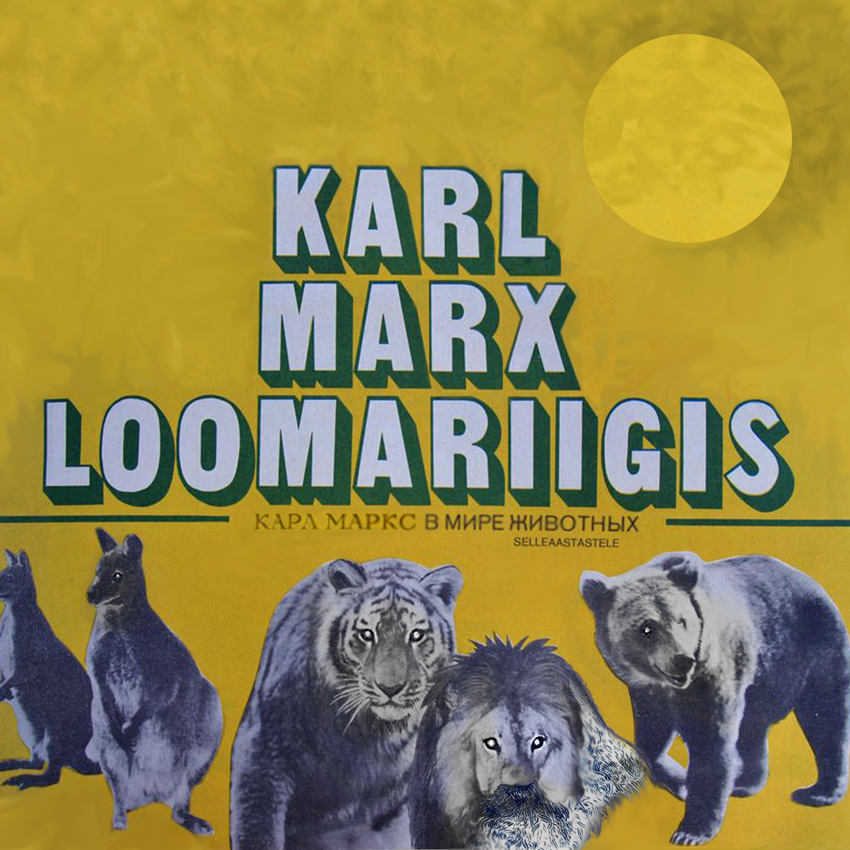“When I was in the seventh grade, I took part in the competition of designing a board game inspired by the natural world. My invention was awarded the 2nd prize, and the 1st prize was not given out. They decided to place my game into production – before that, the rules were adjusted and simplified; the artist designed the board and the packaging that were depicting animals. The product was titled “Journey in the Animal Kingdom” and tens of thousands of copies of the game were printed. Even the reprints of the product were made later.
Current exhibition Karl Marx in the Animal Kingdom is like a journey back to my childhood. I was inspired by handy materials while I was creating the animal game – mostly the heaps of books with animal photos that were in my home. As a child, I had often been browsing through these books and several images had been etched into my deepest memory. At the same time I was even more interested in the political map of the world, numerical data and short descriptions of various countries that I could find in a guide titled „Countries in the World“. I have also been trying to assemble the images of the animals and political geography in a mechanical way. Creating “real” animal kingdoms started in an alphabetical order – countries for antelopes, monkeys etc. Every “kingdom” was naturally provided with a special flag and coat of arms. Yet, the most important thing was to find the most accurate social and economical solutions for the animal species. Democracy for monkeys and kingdom for antelopes? Is capitalism suitable for wolves, the national animal of today’s Estonia? What is the most popular religion in the country of hares? Well, I never reached these last questions since I could not cover more that the species beginning with H and J while compiling the alphabetical review of animal kingdoms.
Anthropomorphism – the attribution of human traits, emotions etc. to non-human entities, such as (toy) animals – is considered to be an innate tendency of human psychology and is a phenomenon that develops in early childhood. Attaching the functioning of human society to animals could be one of the extended forms of expression of this phenomenon. A game where the existing elements are the basis for creating new combinations based on form and where all game pieces are equal. On the contrary to equality, one of the philosophical belief expressing the relationship between men and animals is based on the statement that human beings stand apart from the rest of the natural world. Humans are just like detached from nature and is only functioning due to the continuous state of opposition.
Hasso Krull has described similar concept of human nature as follows: „… a human being is an animal to another human being – however, instead of being friendly they are hostile, immediately becoming aggressive when they are being approached too close and without warning. The animal inside of a man is a predator, and natural society is predatory. Such confession of faith provides a good foundation for the ideology of liberal capitalism according to which altruistic impulses must be suppressed. Such ideology continuously emphasizes that true wellness will be achieved only through the contradiction of egoistic interests.”
Confrontations, either black-and-white and colourful ones, can be found in the artwork exhibited at the current exposition. Therewith, one of these pieces, a painting bearing a black-and-white confrontation, is one of the most lightweight painting in Estonian – one square meter of the painting weighs less than 30 grams. The guest artist of current exhibition is Reet Ohna from Otepää. She is the artist who designed the board game “Journey in the Animal Kingdom” that went into production. We did not know each other before the exhibition.
Erki Kasemets
Erki Kasemets (b. 1969) is an artist living and working in Tallinn. He has studied at the Estonian Academy of Arts. Kasemets’s artwork can be characterized by bricoleur style and sustainable thinking based on materials at hand and by biographical subject matter. Among his creative means of expression are object painting and panel painting, trash art, polygon theatre, games and other performing arts, collecting, documenting, grouping „Vedelik“, environmental and stage design etc. The interwovenness of Kasemets’s life and creative practice throughout several decades is best expressed by his artwork „Life-File“ – collection that includes thousands of milk and juice cartons that have been painted over. Presently the artist is creating a forest path marked by art in Harju county, Estonia.
Exhibition will be open until January 9, 2021.
Exhibitions in Draakon gallery are supported by the Cultural Endowment of Estonia, Estonian Ministry of Culture and Liviko Ltd.
Gallery name: Dragon gallery
Address: Pikk 18, Tallinn
Opening hours: Mon-Fri 11:00 - 18:00, Sat 11:00 - 17:00
Open: 15.12.2020 - 09.01.2021







